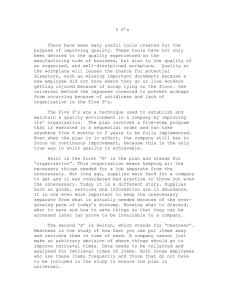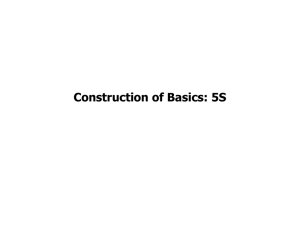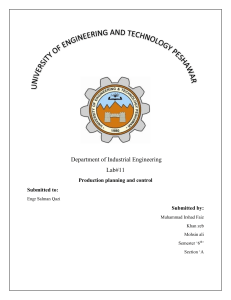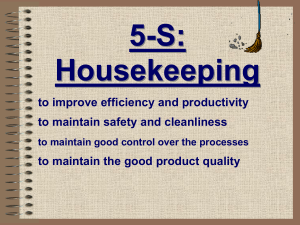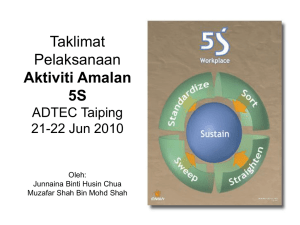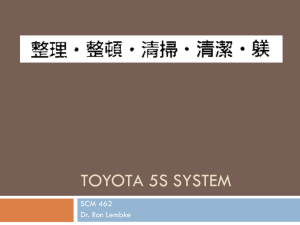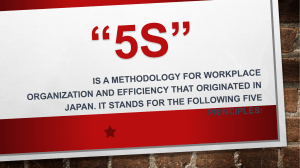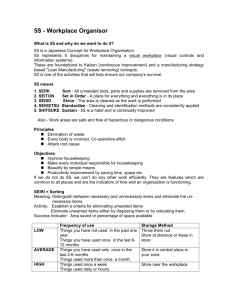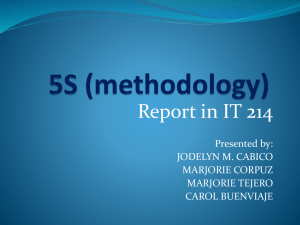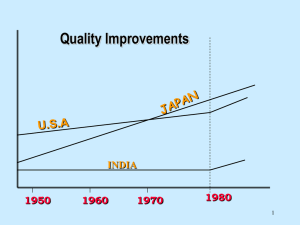Principles of 5 S
advertisement
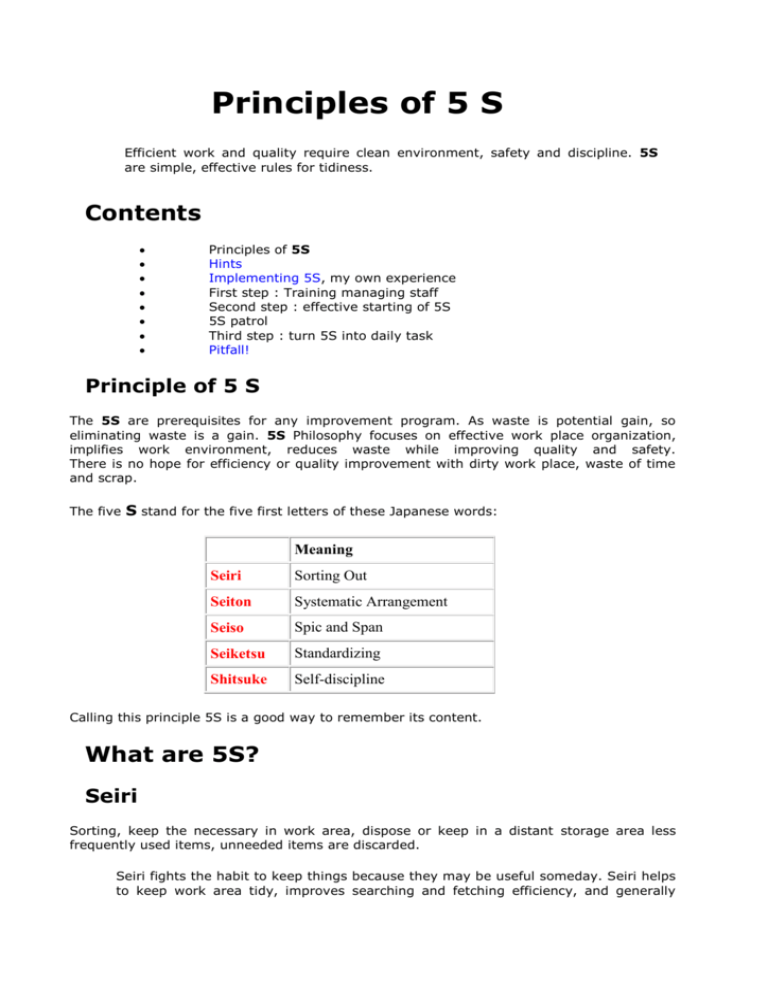
Principles of 5 S Efficient work and quality require clean environment, safety and discipline. 5S are simple, effective rules for tidiness. Contents Principles of 5S Hints Implementing 5S, my own experience First step : Training managing staff Second step : effective starting of 5S 5S patrol Third step : turn 5S into daily task Pitfall! Principle of 5 S The 5S are prerequisites for any improvement program. As waste is potential gain, so eliminating waste is a gain. 5S Philosophy focuses on effective work place organization, implifies work environment, reduces waste while improving quality and safety. There is no hope for efficiency or quality improvement with dirty work place, waste of time and scrap. The five S stand for the five first letters of these Japanese words: Meaning Seiri Sorting Out Seiton Systematic Arrangement Seiso Spic and Span Seiketsu Standardizing Shitsuke Self-discipline Calling this principle 5S is a good way to remember its content. What are 5S? Seiri Sorting, keep the necessary in work area, dispose or keep in a distant storage area less frequently used items, unneeded items are discarded. Seiri fights the habit to keep things because they may be useful someday. Seiri helps to keep work area tidy, improves searching and fetching efficiency, and generally clears much space. Seiri is also excellent way to gain valuable floor space and eliminate old broken tools, obsolete jigs and fixtures, scrap and excess raw material. Seiton Systematic arrangement for the most efficient and effective retrieval. A good example of Seiton is the tool panel. Effective Seiton can be achieved by painting floors to visualize the dirt, outlining work areas and locations, shadow tool boards. For improving changeover time with SMED or reduce machine downtime throught Total Productive Maintenance (TPM) it is necessary to have tools at hand. So a specific mobile tool cart was designed. An other example of Seiton are "broom carts". As cleaning is a major part of 5S we custom made carts to hold brooms, mops and buckets. Several carts have specific locations and all employees can find them. Seiton saying would be: "A place for everything and everything on its place." Seiso Cleaning. After the first thorough cleaning when implementing 5S, daily follow-up cleaning is necessary in order to sustain this improvement. Cleanliness is also helpful to notice damages on equipment such as leaks, breakage and misalignment. These minor damages, if left unattended, could lead to equipment failure and loss of production. Regular cleaning is a type of inspection. Seiso is an important part of basic TPM; Total Productive Maintenance and Safety matter through cleanliness is obvious. Seiketsu Standardizing. Once the first three S have been implemented, it should be set as a standard so to keep these good practice work area. Without it, the situation will deteriorate right back to old habits. Have an easy-to-follow standards and develop a structure to support it. Allow employees to join the development of such standards. The 3 firts S are often executed by order. Seiketsu helps to turn it into natural, standard behaviour. Shitsuke Finally, to keep first 4 S alive, it is necessary to keep educating people maintaining standards. By setting up a formal system; with display of results, follow-up, the now complete 5S get insured to live, and be expanded beyond their initial limits, in an ongoing improvement way; the Kaizen way. The effect of continuous improvement leads to less waste, better quality and faster lead times. Hints to 5S The 5S principle is gradual and necessarily in that order. 5S are for everybody, it is hopeless expectation for subordinates to follow 5S if manager class does not comply to it. 5S show efficiency in time, transforming the physical environment of work area and spirit of all employee levels. All this seems obvious? Looks easy? Of course there is nothing really new, but before saying it is so simple or even doubt its efficiency, try to set up 5S for yourself, for your unit. You will see difficulties and reluctance, so called resistance to change, the natural tendency to return to the status quo and the good old way. After succeeding in setting up 5S, don't forget to keep them alive! Implementing 5S, my own experience As 5S are fundamental prerequisite for Japanese industrial methods, implementing them in a formal way was a major project, from the start of our unit. First step : Training managing staff The first training was given to managers, foremen and line leaders. In addition to the course, frequent visits on the shop floor revealed numerous examples of lack of order, tidiness, but dust, obsolete parts or documents still lying around... This was the moment to memorize initial status and kick-off improvement ideas. (In the same time we worked on 5S, we introduced KAIZEN spirit) Taking pictures to keep in mind original state, by collecting more pictures as project goes on, makes a nice before/after album. Those visits on the ground were invasions, as no drawer or closet was safe before inspectors, showing lack of personal 5S. Second step : effective starting of 5S Managers, foremen and line leaders taught the 5S spirit and techniques to their teams, topdown. Once explanations given, first improvement ideas, enriched with the new ones, from workers, technicians and employees, were given a planning for action. The plant was sliced into sectors and responsibility of 5S split among the sections. Top management issued basic 5S rules, a kind of table of laws, stating about stacking heights, stacking zones and so on. Over five months, one S per month, sections had to turn ideas (e.g: planned actions) into reality. First actions consisted mainly in cleaning, sorting and marking inventory zones, corridors... Progress and compliance to rules were monitored by a monthly 5S patrol. 5S patrol Some managers, foremen or line leaders were entitled both as responsible for 5S in their area and patrolman. Chairman of that organization was the Quality Insurance manager. To involve everybody, two different workers were chosen each month, to join the patrol. Patrol used evaluation sheets, based on the company rules. A couple of "inspectors" were given several sectors to check. Two patrols could check a same sector. Patrol planning was done so that each sector was checked over the months. At the end of each audit (patrol), evaluation sheets with notes and remarks were gathered and discussed. The 5S committee chairman (Quality Insurance manager) gathered the sheets and calculated a global result. A chart with all results was finally displayed. 5S Improvement Requests could be issued to some responsible person, requesting a concrete answer to some specific point. This person should respond quickly, proposing a deadline for clearing that troublesome point. Third step : turn 5S into daily task When 5S were kicked-off and this system understood, it was ready to be turned into regular job. Yearly 5S target were assigned to divisions, as a part of their quality targets. Average result of all monthly 5S audits should meet that target. So patrols were kept after kick-off period. Some pitfalls An essential condition for long term success of 5S is management's commitment. Managing staff must keep pressure to avoid natural behaviors to ruin the first achievements. Themselves must behave like examples. To admit twists to 5S rules will poison them, making long term commitment questionable. Evaluation standard criterion must adapt to specific conditions, for example to avoid production staff to claim about constraints office workers don't have; cleanliness and tidiness is easier to keep in office than workshop...
